For John Charlton, eldest son of Walter and Mary Charlton of Castle Creek, a small settlement near Euroa in central Victoria, deployment to the South African Boer War couldn’t come quick enough. Although volunteering early in the conflict, a serious leg injury prevented him from being sent overseas until 1901 where he served with the 5th Victorian Mounted Rifle Contingent. Unfortunately John’s service would be cut short, with him falling ill of enteric fever eventually dying on 16th August 1901 aged 23 years and being buried at Pretoria, South Africa.
Upon receiving the news of John’s death, his family and indeed the whole township of Euroa went into mourning. As devout Christians, the Charlton family gained solace from their local church minister, the Reverend Major Wray, who had also been hospitalised with enteric fever at the same time as John. For the Charlton’s, the knowledge that Wray had also fought in the 5th VMR Contingent and had known their son provided immense comfort and his offer to personally conduct a ‘funeral service’ in memory of John was even more poignant.
The memorial service, patronised by a large gathering from across the region was conducted on 3rd September 1901 at the local Castle Creek School where John once attended. To reflect the solemn occasion, the hall was “…draped in black… being relieved with “…beautiful wreaths of white flowers”.
John was held in such high regard that at the conclusion of the service, his family, many of John’s 5th Contingent comrades and officers, as well as members of the local community discussed their desire to establish some form of permanent memorial to John’s memory. Within weeks of John’s death, fundraising activities for the erection of a memorial window had begun with Rev. Major Wray conducting a series of lantern lectures on “The Incidents of War in South Africa”. By late 1902 sufficient funds had been collected and the design for a stained glass, lead-light memorial window had been selected.
The memorial was to be erected in the new chancel of St. Paul’s Anglican Church, Euroa, with the opening and dedication being conducted by Archdeacon Hindley of Melbourne on 13 January 1903. Local newspapers of the time described the memorial as being a “…massive three light window surmounted by a star…” encased in a large Californian redwood cedar frame and said to have been made of “…the best cathedral glass provided by Brooks, Robinson & Co of Melbourne…”, the design of which was reported to be “…rich, but not gaudy…” and inspired by the words of St. Paul’s Epistle to the Ephesians.
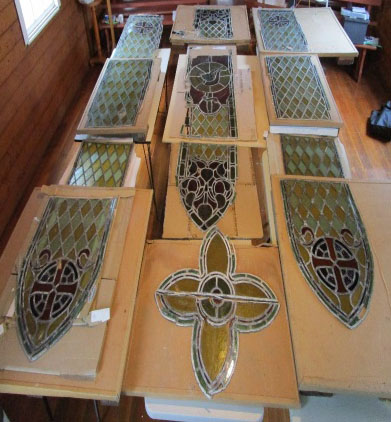
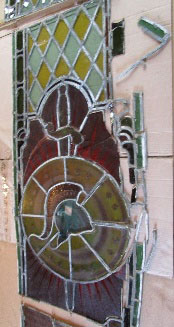
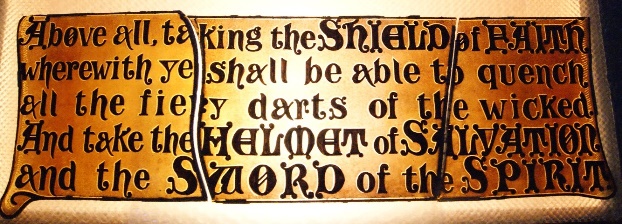
John’s memory was further enhanced by members of the 5th Contingent who also donated a small inscribed handcrafted panel which was sympathetically decorated with hand painted quarries matching those of the memorial window and overlain with an inscription which read: In Memory of John Charlton, of the 5th Contingent.
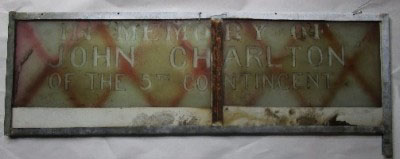
For nearly thirty years the massive three-section window dominated the east end of the church building, functioning as an integral part of Church worship as well as operating as a memorial to a lost son and community member and as an ‘aide du memoir’ of the Boer War. Unfortunately the importance of these meanings would change as Anglican Churches throughout Australia began to transform and extend their buildings to a common ecclesiastical design. The Euroa Church began this process with plans for a new extension necessitating the removal of the Charlton three light memorial window and surround. The window’s red cedar casement was sold at auction, while the three light window was reverently removed, placed in wooden boxes and stored under the floor boards of the new chancel. Thus began the first stage in the moderation of John’s memory and the dimming of his light.
Mindful of the importance of the memorial window to John’s family and the community, the Church guardians agreed to erect another window to his memory as compensation. In 1939, a new window costing £40.0.0 was commissioned. Designed by Mathieson & Gibson of Melbourne, a single figurative lancet depicting St. Martin of Tours was selected. This replacement window was located at the rear of the Church alongside other similarly sized memorial lancets.
The symbolism of the original concepts of John’s memory were now diminished having changed considerably in design, size, location and inscription. The symbolism had changed from using the weaponry of war and its associated might and fury in the service of God and a life beyond death, to a softer, more conciliatory, or benevolent meaning with Saint Martin portrayed as a roman soldier sharing his cloak with a beggar reflecting the Christian values of helping the less fortunate. St. Martin is portrayed as a soldier dressed in military styled tunic, cloak and boots, with chest and breast plate armour and sword in hand. Less intent on using weapons to defend the faith and repel evil, St. Martin’s image reflects a change in the Church’s philosophical approach to war and later, memorials. The window no longer drew one’s focus as it once had when located above the altar at the front of the church; its size was now minimal compared to the original memorial and its design incorporating art nouveau elements and hard abstract forms had disappeared. The new inscription departed from the original 1903 biblical reference to one now only recording John’s name, regiment, place and date of death.
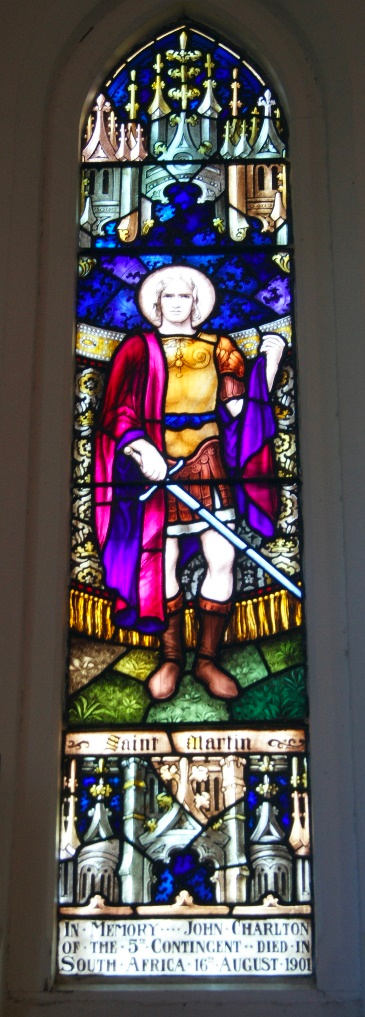
Either forgotten or no longer considered a relevant or fitting memorial the window remained lost until some eighty years later when the Church again underwent further renovation. The renovation would see the re-discovery of John’s three light and star memorial window hidden beneath the floorboards of the Church, covered in decades of dust and animal droppings
Beginning with the window’s removal and subsequent substitution to the rear of the Church, to the death of two more brothers in World War 1 and the relocation of family members away from the district, John’s memory was seemingly almost extinguished. The rediscovery of his window provides an opportunity to reinstate his memory, although just how, remains the question.
The memorial window is now out of context and due to the passage of time its stability and condition has deteriorated. It would be gratifying to find a new home for the three light window and John Charlton’s memory. The re-discovery of John’s window provides an opportunity to restore its condition and to provide Victoria with an important and unique piece of war-related heritage devoted to the Boer War period. Significantly the three light memorial window is one of only a few Boer War memorial windows; it is unique in its design with no other window like it in existence; it is an example of one family and its community’s endeavour to preserve a soldier’s memory and is a unique part of the Boer War and the 5th Contingent’s history.
The researchers hope to find a new home for the window, preferably within the district in which it was first raised and are seeking help in reinstating John’s memory. If you can assist please contact Maxine on email: maxleeboyd@gmail.com
By Lynne Dore and Maxine Boyd 2014
Submitted 2nd November 2014 to Boer War Memorial Association “for publication in “Boer War Despatches”
Contact MHHV Friend about this article.






